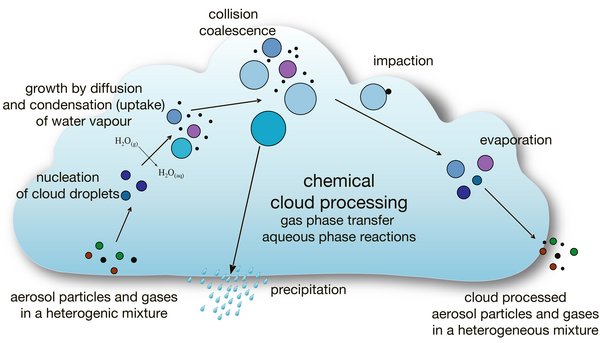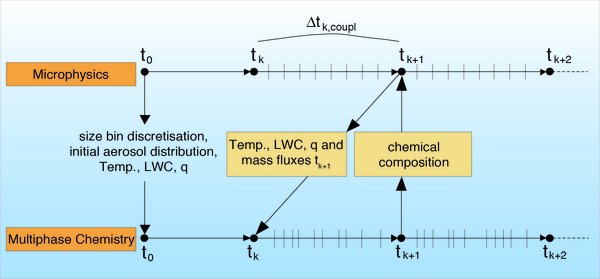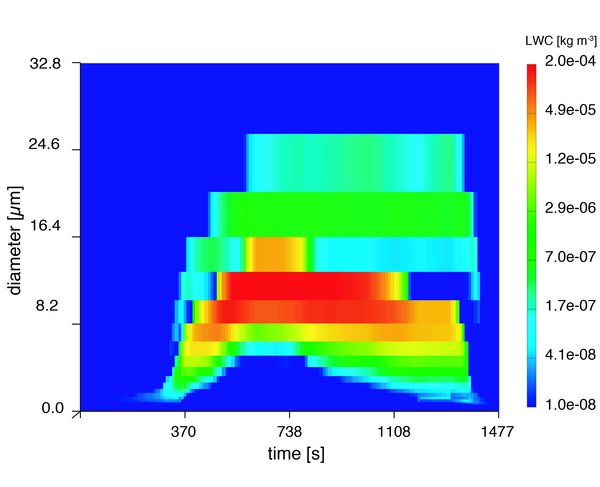
Fig. 1: Schematic depiction of the microphysical and multiphase chemical processes of warm clouds considered in SPACCIM. Source: Ralf Wolke/TROPOS

SPectral Aerosol Cloud Chemistry Interaction Model (SPACCIM)
In order to examine the coupled microphysical and multiphase chemical processes in the troposphere (see Fig. 1) by means of a complex numerical model, the spectral air parcel model SPACCIM was developed in the modelling department of the TROPOS. SPACCIM combines a complex size-resolved multiphase chemistry model and cloud-microphysical model. The interaction between both models is described by a coupling scheme (see Fig. 2) that allows the microphysical and chemical model to run so far as possible separately from each other, i.e. enabling both models to use their own time step control. The multiphase chemical system is integrated by a high-order implicit scheme, which exploits the special sparse structure of the model equations (Wolke and Knoth, 2002). The microphysical model applied in SPACCIM model framework is mainly based on the work of Simmel and Wurzler (2006) and Simmel et al. (2005).
In the microphysical model, the growth and shrinking of aerosol particles by water vapour diffusion as well as nucleation and growth/evaporation of cloud droplets and other microphysical processes such as impaction of aerosol particles and collision/coalescence of droplets are described explicitly (see Fig. 1). The dynamic growth rate in the condensation/evaporation process as well as the droplet activation is based on Köhler theory. The cloud droplet formation, evolution and evaporation are implemented using a one-dimensional sectional microphysics considering deliquesced particles and cloud droplets, respectively. The microphysical model provides the meteorological and cloud microphysical parameters, such as temperature, humidity and liquid water content, but is also controlled by processes of the chemistry model. The coupling scheme accounts for the interpolation of the meteorological data as well as the averaging of physical and chemical mass fluxes that occur within the particle/droplet spectrum due to microphysical and chemical processes.
In SPACCIM, chemical mechanisms of different complexity can be applied for modelling the multiphase chemistry in both deliquesced particles and cloud droplets. The currently most advanced applied multiphase mechanism consists of the gas-phase mechanism MCMv3.2 (http://mcm.york.ac.uk) and the aqueous-phase mechanism CAPRAM (Chemical Aqueous Phase Radical Mechanism, version 4.0, Bräuer et al. (2019)).
In the past, SPACCIM has been used for several studies and applications (see references below) focusing on chemical processes in the tropospheric multiphase system. Besides the investigation on cloud processes, current studies deal also with deliquesced aerosol particles such as the multiphase organic particle mass processing and dissolution processes on mineral dust particles. For this reason, an activity coefficient model has been recently implemented in SPACCIM that considers the effect of non-ideal solutions and the feedback on the multiphase chemistry (Rusumdar et al. 2016, 2020).

Fig. 1: Schematic depiction of the microphysical and multiphase chemical processes of warm clouds considered in SPACCIM. Source: Ralf Wolke/TROPOS

Fig. 2: Schema of the model coupling approach considered in SPACCIM (adopted from Wolke et al. 2005 and Rusumdar et al. 2016). Source: Ralf Wolke/TROPOS

Fig. 3: Modelled Liquid Water Content (LWC) during a passage of an orographic hill cap cloud. Source: Andreas Tilgner/TROPOS
References
Bräuer, P., A. Tilgner, R. Wolke, and H. Herrmann (2013), Mechanism development and modelling of tropospheric multiphase halogen chemistry: The CAPRAM Halogen Module 2.0 (HM2), J Atmos Chem, 1-34, doi: 10.1007/s10874-013-9249-6.
Bräuer, P., Mouchel-Vallon, C., Tilgner, A., Mutzel, A., Böge, O., Rodigast, M., Poulain, L., van Pinxteren, D., Wolke, R., Aumont, B., Herrmann, H. (2019), Development of a protocol for the auto-generation of explicit aqueous-phase oxidation schemes of organic compounds, Atmos. Chem. Phys., 19, 9209-9239, doi: 10.5194/acp-19-9209-2019.
Deguillaume, L., A. Tilgner, R. Schrodner, R. Wolke, N. Chaumerliac, and H. Herrmann (2009), Towards an operational aqueous phase chemistry mechanism for regional chemistry-transport models: CAPRAM-RED and its application to the COSMO-MUSCAT model, J Atmos Chem, 64(1), 1-3, doi: 10.1007/s10874-010-9168-8.
Gatzsche, K., Iinuma, Y., Tilgner, A., Mutzel, A., Berndt, T., Wolke, R. (2017), Kinetic modeling studies of SOA formation from α-pinene ozonolysis, Atmos. Chem. Phys., 17, 13187-13211, doi: 10.5194/acp-2017-275.
Herrmann, H., A. Tilgner, P. Barzaghi, Z. Majdik, S. Gligorovski, L. Poulain, and A. Monod (2005), Towards a more detailed description of tropospheric aqueous phase organic chemistry: CAPRAM 3.0, Atmos Environ, 39(23-24), 4351-4363, doi: 10.1016/j.atmosenv.2005.02.016.
Hoffmann, D., A. Tilgner, Y. Iinuma, and H. Herrmann (2010), Atmospheric Stability of Levoglucosan: A Detailed Laboratory and Modeling Study, ENVIRONMENTAL SCIENCE & TECHNOLOGY, 44(2), 694-699, doi: 10.1021/es902476f.
Hoffmann, E. H., Tilgner, A., Schrödner, R., Bräuer, P., Wolke, R., Herrmann, H. (2016), An advanced modeling study on the impacts and atmospheric implications of multiphase dimethyl sulfide chemistry, Proc. Nat. Acad. Sci. (PNAS), 113, 11776–11781, doi:10.1073/pnas.1606320113.
Hoffmann, E. H., Tilgner, A., Wolke, R., Böge, O., Walter, A., Herrmann, H. (2018), Oxidation of substituted aromatic hydrocarbons in the troposphere aqueous phase: Kinetic mechanism development and modelling, Phys. Chem. Chem. Phys., 20, 10960-10977, doi: 10.1039/C7CP08576A.
Hoffmann, E. H., Tilgner, A., Wolke, R., Herrmann, H. (2019), Enhanced chlorine and bromine atom activation by hydrolysis of halogen nitrates from marine aerosols at polluted coastal areas, Environ. Sci. Technol., 53, 771-778, doi: 10.1021/acs.est.8b05165.
Hoffmann, E. H., Tilgner, A., Vogelsberg, U., Wolke, R., Herrmann, H. (2019), Near-explicit multiphase modeling of halogen chemistry in a mixed urban and maritime coastal area, ACS Earth Space Chem., 3, 2452-2471, doi: 10.1021/acsearthspacechem.9b00184.
Hoffmann, E. H., Schrödner, R., Tilgner, A., Wolke, R., Herrmann, H. (2020), CAPRAM reduction towards an operational multiphase halogen and dimethyl sulfide chemistry treatment in the chemistry transport model COSMO-MUSCAT(5.04e), Geosci. Model Dev., 13, 2587-2609, doi: 10.5194/gmd-13-2587-2020.
Rusumdar, A. J., Wolke, R., Tilgner, A., Herrmann, H. (2016), Treatment of non-ideality in the SPACCIM multiphase model – Part 1: Model development, Geosci. Model Dev., 9, 247-281, doi: 10.5194/gmd-9-247-2016.
Rusumdar, A. J., Tilgner, A., Wolke, R., Herrmann, H. (2020), Treatment of non-ideality in the SPACCIM multiphase model - Part 2: Impacts on the multiphase chemical processing in deliquesced aerosol particles, Atmos. Chem. Phys., 20, 10351-10377, doi: 10.5194/acp-20-10351-2020.
Sehili, A. M., R. Wolke, O. Knoth, M. Simmel, A. Tilgner, and H. Herrmann (2005a), Comparison of different model approaches for the simulation of multiphase processes, Atmos Environ, 39(23-24), 4403-4417, doi: 10.1016/j.atmosenv.2005.02.039.
Sehili, A.-M., Wolke, R., Helmert, J., Simmel, M., Schröder, W., Renner, E., (2005b), Cloud chemistry modeling: Parcel and 3D simulations. In: Borrego, C., Norman, A.L. (Eds.), Air Pollution Modeling and Its Application XVII, Kluwer Academic Publishers, New York.
Simmel, M., K. Diehl, and S. Wurzler (2005), Numerical simulation of the microphysics of an orographic cloud: Comparison with measurements and sensitivity studies, Atmos Environ, 39(23-24), 4365-4373, doi: 10.1016/j.atmosenv.2005.02.017.
Simmel, M., and S. Wurzler (2006), Condensation and activation in sectional cloud microphysical models, Atmos Res, 80(2-3), 218-236, doi: 10.1016/j.atmosres.2005.08.002.
Tilgner, A., P. Bräuer, R. Wolke, and H. Herrmann (2013), Modelling multiphase chemistry in deliquescent aerosols and clouds using CAPRAM3.0i, J Atmos Chem, 70(3), 221-256, doi: 10.1007/s10874-013-9267-4.
Tilgner, A., and H. Herrmann (2010), Radical-driven carbonyl-to-acid conversion and acid degradation in tropospheric aqueous systems studied by CAPRAM, Atmos Environ, 44, 5415-5422, doi: 10.1016/j.atmosenv.2010.07.050.
Tilgner, A., Z. Majdik, A. M. Sehili, M. Simmel, R. Wolke, and H. Herrmann (2005), SPACCIM: Simulations of the multiphase chemistry occurring in the FEBUKO hill cap cloud experiments, Atmos Environ, 39(23-24), 4389-4401, doi: 10.1016/j.atmosenv.2005.02.028.
Weller, C., Tilgner, A., Bräuer, P., Herrmann, H. (2014), Modeling the impact of iron-carboxylate photochemistry on radical budget and carboxylate degradation in cloud droplets and particles, Environ. Sci. Technol., 48, 5652-5659, doi: 10.1021/es4056643.
Whalley, L. K., Stone, D., George, I. J., Mertes, S., van Pinxteren, D., Tilgner, A., Herrmann, H., Evans, M. J., Heard, D. E. (2015), The influence of clouds on radical concentrations: Observations and modelling studies of HOx during the Hill Cap Cloud Thuringia (HCCT) campaign in 2010, Atmos. Chem. Phys., 15, 3289-3301, doi: 10.5194/acp-15-3289-2015
Wolke, R., A.M. Sehili, M. Simmel, O. Knoth, A.Tilgner, H. Herrmann (2005), SPACCIM: A parcel model with detailed microphysics and complex multiphase chemistry, Atmos. Env., 39, 4375-4388, doi: 10.1016/j.atmosenv.2005.02.038.
Wolke, R., and O. Knoth (2002), Time-integration of multiphase chemistry in size-resolved cloud models, Applied Numerical Mathematics, 42, 473–487, doi: 10.1016/S0168-9274(01)00169-6.
Ye, C., Chen, H., Hoffmann, E. H., Mettke, P., Tilgner, A., He, L., Mutzel, A., Brüggemann, M., Poulain, L., Schaefer, T., Heinold, B., Ma, Z., Liu, P., Xue, C., Zhao, X., Zhang, C., Zhang, F., Sun, H., Li, Q., Wang, L., Yang, X., Wang, J., Liu, C., Xing, C., Mu, Y., Chen, J., Herrmann, H. (2021), Particle-phase photoreactions of HULIS and TMIs establish a strong source of H2O2 and particulate sulfate in the Winter North China Plain, Environ. Sci. Technol., 55, 7818-7830, doi: 10.1021/acs.est.1c00561.